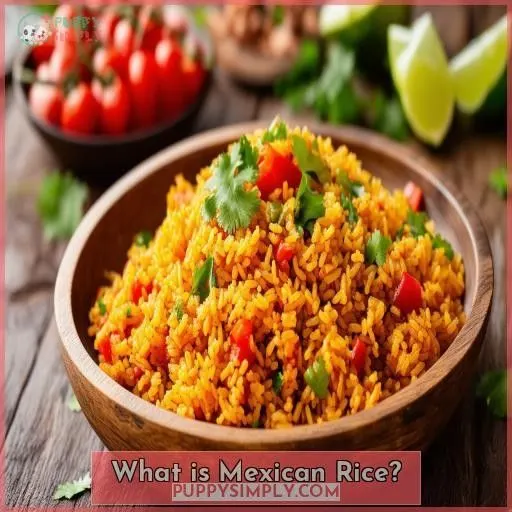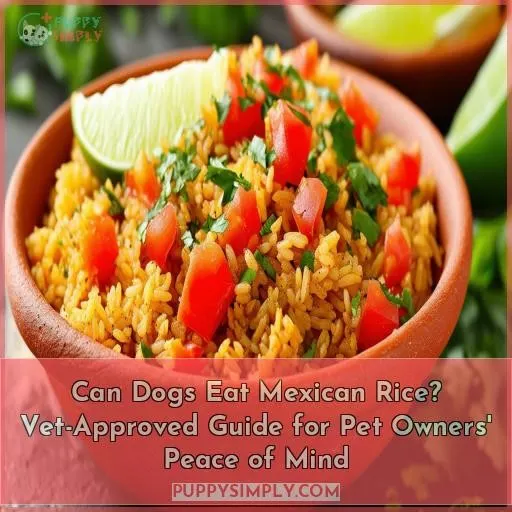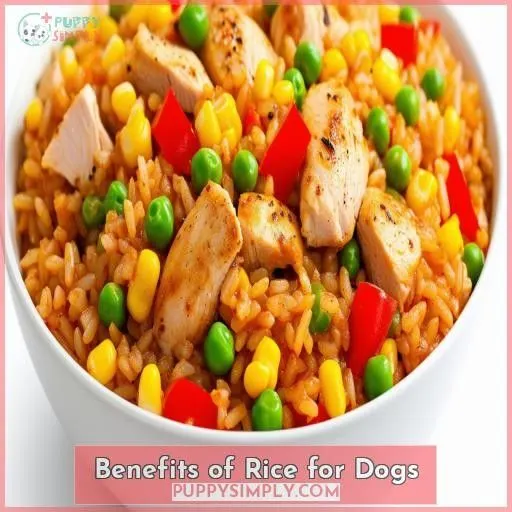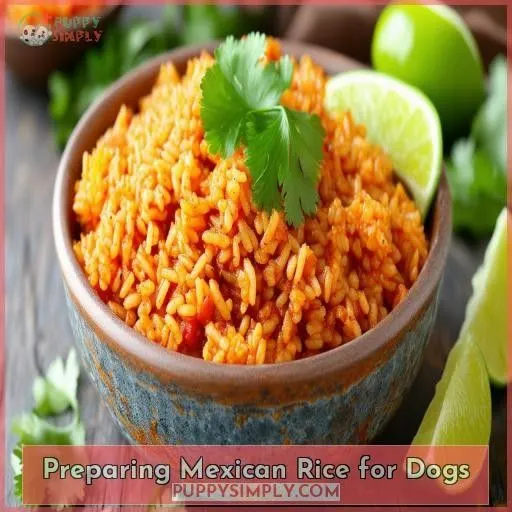This site is supported by our readers. We may earn a commission, at no cost to you, if you purchase through links.
 You’re questioning if dogs can consume Spanish rice. While it’s not toxic, it can pose some risks.
You’re questioning if dogs can consume Spanish rice. While it’s not toxic, it can pose some risks.
Spanish rice typically includes garlic and onions, which are harmful to dogs, and spices or tomatoes that might upset their stomachs. However, plain, unseasoned rice provides energy and essential nutrients.
If you decide to share, make certain it’s free of harmful ingredients like garlic and onions, and keep it bland. Symptoms like vomiting or loss of appetite may signal a problem, so keep an eye on your pup.
Want to ensure your furry friend stays safe with their treats? Explore further!
Table Of Contents
- Key Takeaways
- Can Dogs Eat Spanish Rice?
- What is Mexican Rice?
- Can Dogs Eat Mexican Rice?
- Benefits of Rice for Dogs
- Preparing Mexican Rice for Dogs
- Symptoms to Watch For
- When to Seek Veterinary Care
- Frequently Asked Questions (FAQs)
- Is Mexican rice ok for dogs to eat?
- Can dogs eat Spanish yellow rice?
- What kind of rice can dogs not eat?
- What type of rice is best for dogs?
- Is Spanish rice safe for dogs?
- Can spices in Spanish rice harm dogs?
- What to do if my dog eats Spanish rice?
- How to prepare dog-friendly Spanish rice?
- Is rice a good energy source for dogs?
- Conclusion
Key Takeaways
- Fido can dig in, but hold the spice! Spanish rice often contains garlic and onions that are toxic to our furry friends. Their sensitive tummies deserve a bland, unseasoned rice dish.
- Rice itself is a solid energy source and easy on doggy digestion. But like a parent with a picky eater, you’ll want to keep an eye out for any tummy troubles after trying a new dish.
- If your pup accidentally wolfs down some Spanish rice, don’t panic! Monitor for vomiting or loss of appetite, and have that vet’s number on speed dial just in case.
- Want to whip up a dog-friendly version? Start with plain white rice, add a touch of tomato sauce and cumin, and voila! A tail-wagging, belly-filling meal fit for your favorite canine amigo.
Can Dogs Eat Spanish Rice?
Yes, dogs can eat plain white rice in moderation, but Spanish rice with garlic, onions, spices, and tomatoes should generally be avoided as these ingredients can be toxic or difficult for dogs to digest properly. While the rice itself is safe, the seasonings in Spanish rice can cause stomach upset or more serious issues for dogs.
What is Mexican Rice?
Mexican rice is a delicious side dish made from medium-grain white rice, toasted in a pan, and cooked with tomato sauce or puree and cumin seasoning, often including ingredients like garlic, onions, vegetables, or broth. When prepared for dogs, it’s crucial to keep it plain, avoiding harmful ingredients like garlic and onions to guarantee their safety and health.
Definition of Mexican Rice
Mexican rice is a flavorful dish made from medium-grain white rice toasted in a pan, combined with tomato sauce or puree, and seasoned with cumin. Often, additional ingredients such as garlic, onions, vegetables, or broth enhance its taste. It’s a staple with cultural significance, loved for its savory essence and vibrant color .
Ingredients in Mexican Rice
Mexican rice usually includes medium-grain white rice, toasted in a pan, with tomato sauce or puree, cumin seasoning, and sometimes garlic, onions, vegetables, or broth (Source). While it’s tasty for humans, you should remove garlic, onions, and other toxic ingredients before serving any to your dog to avoid potential health risks .
Can Dogs Eat Mexican Rice?
Regarding Mexican rice, it’s critical to ponder potential risks before feeding it to your dog. Ingredients such as garlic, onions, spices, and tomatoes can cause digestive issues and toxicity in dogs, so it’s best to prepare a plain version without these additives.
Potential Risks of Feeding Mexican Rice to Dogs
Feeding Mexican rice to dogs poses several risks including allergies, gastrointestinal upset, and food intolerance that may lead to symptoms like vomiting, stomach sensitivity, and in severe cases, pancreatitis. Anemia could arise from toxic ingredients commonly found in Spanish rice.
Garlic and Onions in Mexican Rice
Garlic and onions are highly toxic to dogs and can cause significant health issues, including gastrointestinal distress and anemia. Always avoid including these vegetables in your dog’s food. Instead, opt for safer herbs and spices like parsley or basil (Source).
Spices and Tomatoes in Mexican Rice
Spices and tomatoes in Mexican rice can upset your dog’s stomach, leading to digestive issues. Use minimal seasonings like cumin and avoid spices altogether. If your dog accidentally eats too many spices, an antacid may help alleviate discomfort .
Benefits of Rice for Dogs
Rice offers lasting energy and valuable nutrients that support your dog’s overall health. Its easy-to-digest nature makes it a reliable ingredient in many commercial dog foods.
Provides Energy and Nutrients
To provide lasting energy and essential nutrients, rice is a beneficial addition to your dog’s diet. It supports their immune system and helps with conditions like IBD flare-ups. Benefits include:
- Steady energy boost
- Important vitamins
- Essential minerals
- Supports puppy nutrition
- Promotes a balanced dog diet
Easy to Digest
Rice’s nutritional value makes it an excellent option for dogs with sensitive stomachs. Its grain sensitivity can help avoid digestive issues. Safe preparation, guaranteeing it’s plain and free of additives, enhances digestive benefits and guarantees a well-tolerated meal.
Common in Dog Food
Rice is a common ingredient in dog food due to its nutritional value. It offers essential nutrients and is gentle on your pet’s stomach. Here are four key benefits of rice in dog food:
- Provides energy
- Supports digestion
- Rich in vitamins
- Easy to digest
Preparing Mexican Rice for Dogs
To prepare Mexican rice for your dog, make sure you rinse and clean the rice thoroughly, and avoid using oils, garlic, and onions. Use minimal tomato puree, and stick to basic ingredients to make certain it’s safe for your dog .
Rinsing and Cleaning White Rice
Rinse and clean white rice thoroughly with cold water to remove impurities . For Mexican rice, soak rice before toasting to guarantee better texture and even cooking .
Avoiding Oils and Seasonings
When preparing Mexican rice for dogs, make sure to toast dry, cook plain, and avoid oils or seasonings. Soaking the rice before toasting is recommended for consistency and ease of digestion.
Using Minimal Tomato or Tomato Puree
Using minimal tomato or tomato puree is essential when preparing Mexican rice for dogs. Consider these steps:
- Stick to plain rice and minimal spices.
- Use fresh tomatoes.
- Avoid canned sauces.
- Monitor for allergies.
Keeping Garlic and Onions Away
To keep your dog safe, you must remove garlic and onions from the Mexican rice. Both ingredients are toxic to dogs and can cause significant health issues, including gastrointestinal distress.
Symptoms to Watch For
When your dog eats Mexican rice, watch for vomiting and loss of appetite, as these could indicate potential gastritis or pancreatitis . Symptoms like these require close monitoring and possibly a visit to the veterinarian .
Vomiting After Eating Mexican Rice
After feeding your dog Mexican rice, watch for vomiting as a potential distress signal. This could indicate a food intolerance or IBD flare-up.
- Gastrointestinal issues
- Consumption of harmful spices
- Over-the-counter antacid may help
- Expert consultation is advised
Loss of Appetite
If your dog experiences loss of appetite after eating Mexican rice, it could indicate GI distress or illness. Monitor for symptoms such as nausea or vomiting, and consider treatments like antacids. Consult your vet if appetite loss persists .
Potential Gastritis or Pancreatitis
If your dog shows vomiting, lethargy, or loss of appetite, it might be dealing with GI issues like gastritis or pancreatitis. Ingestion of wood chips, an IBD flare-up, infectious tracheobronchitis, or kennel cough can also lead to cold-like viruses.
When to Seek Veterinary Care
If your dog ate wood chips or continues vomiting after eating Spanish rice, it’s imperative to seek veterinary care immediately. Abdominal x-rays and administering recommended medications can help assess and treat potential complications effectively .
Ingestion of Wood Chips
Ingestion of wood chips by your dog requires careful monitoring due to potential health risks. Be alert for:
- Choking hazards
- Intestinal blockage
- Tooth damage
- Infection from bacteria or mold
Consult your vet for safety concerns and prevention measures involving pet care.
Abdominal X-rays
If your dog ate Mexican rice and is experiencing digestive upset, abdominal imaging like X-rays is necessary to detect any internal issues caused by ingredients or ingested wood chips. Radiographic findings will help veterinarians make accurate diagnoses and plan treatment.
Administering Recommended Medications
Now that you’ve identified the issue, it’s time to administer recommended medications to help your furry friend feel better. Remember to:
- Follow the prescribed medication dosage carefully.
- Monitor your dog’s response to the medication closely.
- Be prepared to make dietary changes to prevent future issues.
Consult your veterinarian for guidance on antacid administration and potential side effects.
Frequently Asked Questions (FAQs)
Is Mexican rice ok for dogs to eat?
Feeding your dog Mexican rice is like walking a tightrope—safe if the rice is plain and free from garlic, onions, and heavy spices, which can harm their health. Always consult your veterinarian if you’re uncertain.
Can dogs eat Spanish yellow rice?
Dogs can eat Spanish yellow rice if you avoid harmful ingredients like garlic and onions. Make sure to use minimal spices and tomatoes to prevent stomach upset and consult your vet for any concerns .
What kind of rice can dogs not eat?
Whoa there, cowboy! Dogs shouldn’t eat garlic or onion-flavored rice, as these are toxic. Also, be wary of highly seasoned rice like Mexican or Spanish rice, which can cause gastrointestinal distress or upset tummies (Source).
What type of rice is best for dogs?
Brown rice is the best type of rice for dogs. It’s nutrient-dense, rich in fiber, and easy to digest, making it great for dogs with food sensitivities or digestive issues .
Is Spanish rice safe for dogs?
Spanish rice, a tapestry of flavors, isn’t safe for dogs due to garlic and onions, which can harm them. Stick with plain rice or consult your vet for advice on safe ingredients and portion control for your furry friend.
Can spices in Spanish rice harm dogs?
Yes, the spices in Spanish rice can potentially harm your dog. Many spices like garlic, onions, and excessive spiciness can irritate a dog’s digestive system. It’s best to avoid feeding dogs spicy Spanish rice or any dish with toxic ingredients like onions and garlic.
What to do if my dog eats Spanish rice?
If your dog eats Spanish rice, monitor for vomiting or diarrhea. Spices and garlic can upset their stomach. Provide small portions of plain rice and water. Contact your vet if symptoms persist or worsen.
How to prepare dog-friendly Spanish rice?
To prepare dog-safe Spanish rice, start with plain white rice, tomato sauce, and cumin. Avoid garlic, onions, and excess spices. Cook separately before adding any seasonings dogs can’t tolerate. A simple, mild preparation is best for sensitive stomachs.
Is rice a good energy source for dogs?
Rice packs a punch of energy for Fido. It’s an excellent, easily digestible carb source bursting with nutrients and fiber to keep that doggy engine running strong. A smart, dog-approved superfood that’ll have your pup’s tail wagging with delight!
Conclusion
Like a culinary compass, this guide sheds light on whether dogs can eat Spanish rice – a beloved dish laden with risks.
While offering energy and nutrients, its seasoned form harbors dangers like garlic, onions, and spices that could trigger vomiting or appetite loss.













